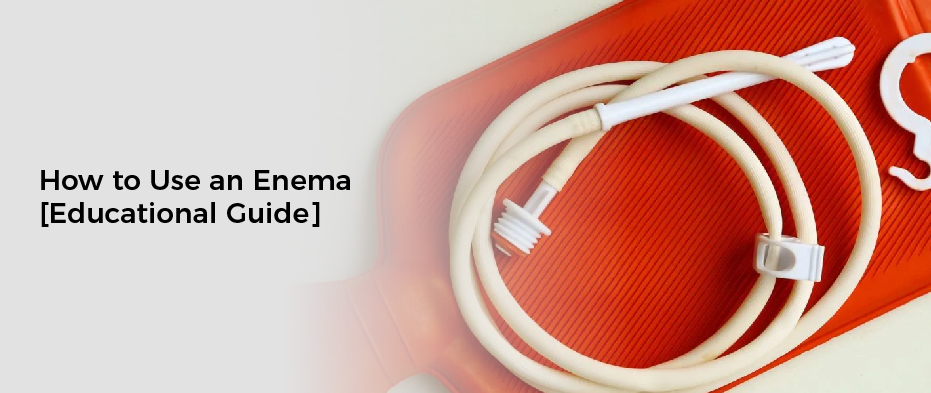An enema is a useful tool for many medical conditions. It can be used to cleanse the colon before a colonoscopy, to screen for colorectal cancer, and to deliver medication directly into the lower intestine and rectum. It can also help treat constipation.
When administering an enema, it is important to follow all instructions provided by your doctor, including how many solutions to use and how long it should remain in the body. Doing so can ensure that the enema is used safely and effectively.
This article discusses the uses of a suppositoryand includes tips for using one safely and correctly. It also emphasizes the importance of talking with your doctor before administering an enema.
Instructions Before Using Enema Kit
- Find a comfortable and private place to administer the enema.
- Gather all the necessary supplies, such as an enema kit, lubricant, and solution.
- Prepare the solution according to the instructions on the package or your doctor’s recommendations.
- Wash your hands with soap and water before getting started.
- Read the instructions included with your enema kit and ensure you understand them before beginning.
- Check the temperature of the solution before administering it—it should be lukewarm, not hot or cold.
- If using a lubricant for the nozzle, use one that is water-soluble and approved for rectal use.
- Wear gloves to avoid contamination of the solution during administration.
- Follow all instructions for administering the suppository, including how many solutions to use and how long it should remain in the body.
What is an Enema Kit?
An enema kit is a collection of equipment used to administer an enema. It typically includes a bag or container for the solution, tubing, and a nozzle that goes into the rectum. Some kits may also include additional items such as gauze or gloves. suppositorykits can be purchased at most pharmacies or online without a prescription, but it’s important to talk with a doctor before using one.
When Should We Use an Enema?
Enemas can be used for various purposes, including relieving constipation, cleaning the colon before certain medical procedures, or treating some conditions such as inflammatory bowel disease. An enema is also sometimes used to introduce substances like medicine or nutrition into the body.
It’s important to talk with your doctor before undertaking an enema. They can tell you whether or not it’s the right course of action for your particular needs and provide instructions on how to use ansuppositorysafely. If done correctly, enemas are generally safe, but they can cause serious complications if used incorrectly.
Method to Use an Enema – Preparation
Enema is a method of cleansing your system. You may use it to help you get rid of a constipated stomach or to relieve a backache. It is also used for certain medical procedures, such as colonoscopies. However, before using an enema, you should consult your healthcare provider.
There are several different types of enemas. They all have their purpose. For example, you can have a cleansing enema that contains baking soda. It is meant to stimulate the large intestine and soften the stool. You may also have a laxative enema. The liquid solution might be made with a mixture of water, salt, and baking soda.
You might be given instructions to fast before the procedure. In addition, you may need to use a special diet. You should follow these instructions carefully and closely.
Common Side Effects
Enemas are administered for a variety of reasons. It may be used to administer medications, relieve constipation or prepare for a medical exam. However, enemas can cause complications if they are not used properly. In some cases, enemas can cause internal organ damage.
Before using an enema, please consult your doctor to make sure that it is safe for you. See a physician immediately if you are experiencing any symptoms such as rectal bleeding or lightheadedness.
Before undergoing a suppository, wash your hands thoroughly. You should also be prepared to use a towel. If you cannot locate a towel, a plastic bottle may work. You can place the bottle near the toilet. It is important to be near the bathroom during the entire procedure.
Symptoms Of a Problem with The Intestinal Mucosa
The mucosa is the innermost layer of the GI tract wall in the digestive system. It is responsible for the secretion of digestive juices and also for the absorption of nutrients. The stomach’s mucosa generally is relatively benign, although it can be susceptible to injury.
A disease like an ulcer may result in inflammation and pain. As with other body parts, the mucosa’s ability to heal is limited by its thinness. However, a simple regimen of antibiotics and anti-inflammatory drugs may suffice. If the underlying condition is chronic, the symptoms will likely persist.
On the other hand, the submucosa is the dense lining that contains nerves and lymphatic vessels. It’s arguably the most important component in the GI tract. Its functions include absorbing nutrients, reducing friction during muscle movement, and allowing blood and fluid to pass easily through it. It also has a modest-sized role in preventing infection and cancer.
Preparation for Surgery While Using Enema
1. Colonoscopy
Enemas are sometimes used to cleanse the colon before a colonoscopy. During this procedure, which is used to diagnose colorectal cancer and other conditions, a doctor examines the inside of your large intestine. Preparing for a colonoscopy usually involves drinking a special solution or taking laxatives the day before the procedure to clear stool from your colon. An enema may also be used for this purpose, depending on your doctor’s recommendations.
When preparing for a colonoscopy with a suppository, follow all instructions provided by your doctor and included with the enema kit. Using an appropriate solution, such as a saline solution or a specialized prep kit, is important. The amount of solution and the time it should remain in the body may vary, so be sure to follow your doctor’s instructions carefully.
2. Cancer Screening
An enema may sometimes be used to screen for colorectal cancer. During this procedure, a special dye is introduced into the large intestine through an enema, and then x-rays are taken of the colon. The dye helps highlight any abnormal areas in the colon that may indicate cancer. This procedure is usually only used in cases where a traditional colonoscopy is impossible or unsuccessful.
3. Constipation
Enemas may be used to help treat constipation, which is when a person has difficulty passing stool or has infrequent bowel movements. They can help reduce the amount of time it takes for waste material to move through the intestines and rectum. Depending on your individual needs, your doctor may recommend using an enema regularly or occasionally to help relieve constipation.
4. Medication
Enemas may also deliver medications directly into the lower intestine and rectum. This method of medication delivery can help treat certain conditions, such as Crohn’s disease, ulcerative colitis, and infections in the gastrointestinal tract.
The type and dosage of medicine used will vary depending on the treated condition. It’s important to follow all your doctor’s instructions when using an enema for medication delivery.
It is also important to take note that administering a suppositorycan be beneficial.It should not be used as a regular part of a health regimen or without medical supervision.
Conclusion
Enemas can be used for many different purposes, from cleaning the colon before a colonoscopy to helping treat constipation. It’s important to talk with your doctor about whether an enema is right for you and get instructions on how to use one properly. Following all instructions and safety precautions can help make sure the enema is used correctly and safely.


